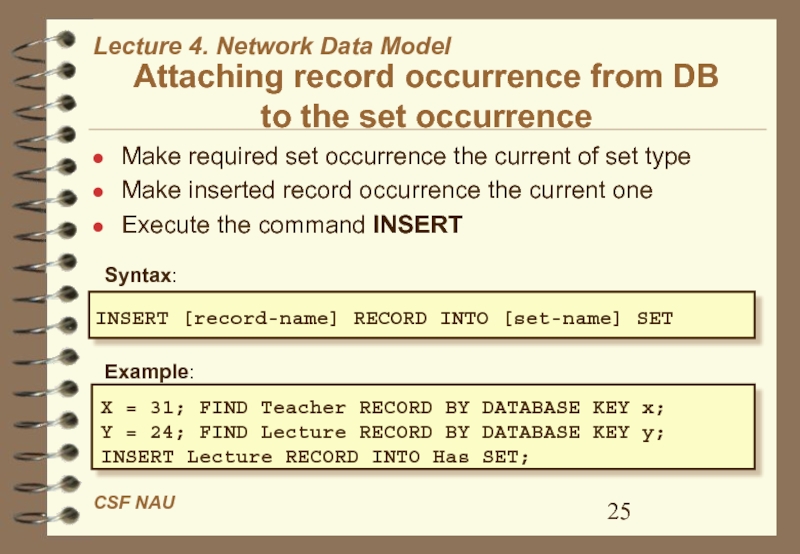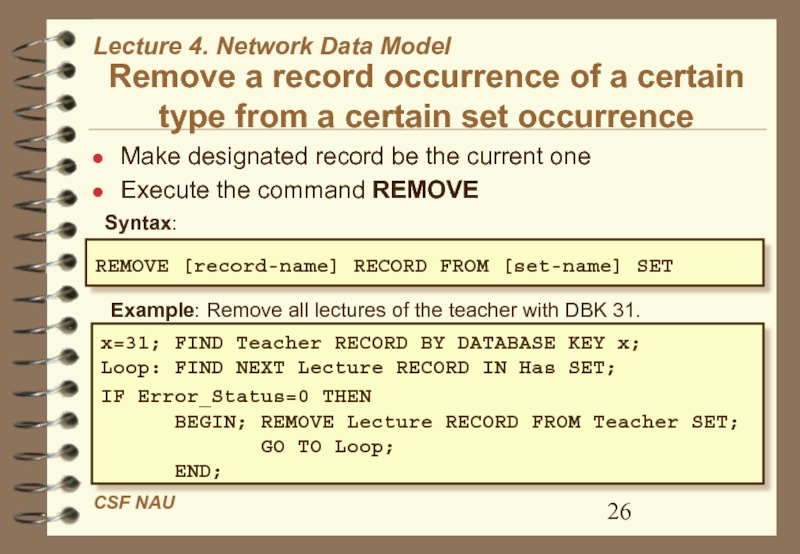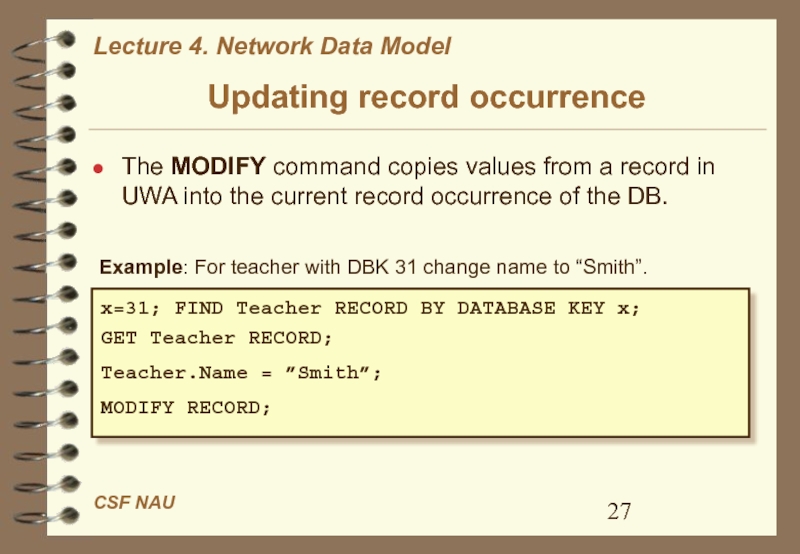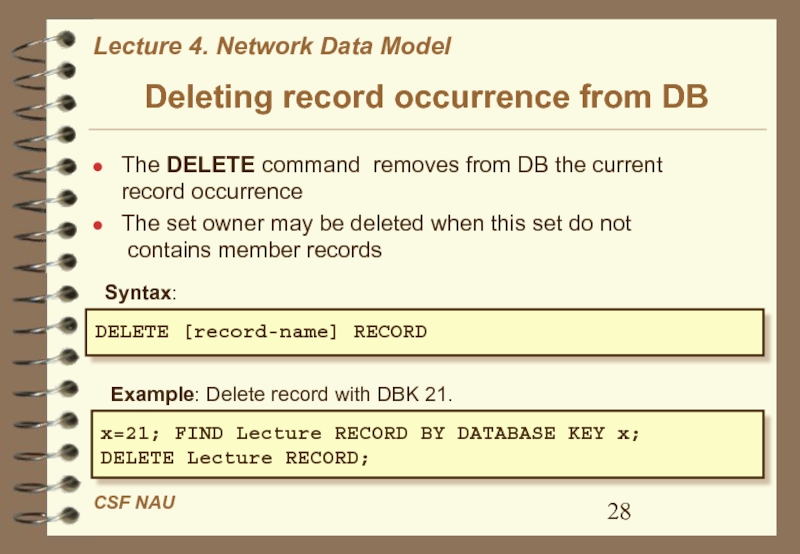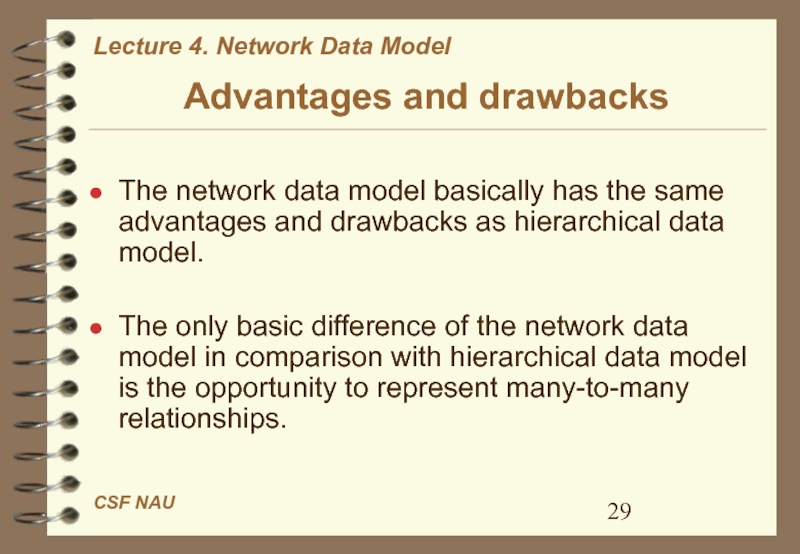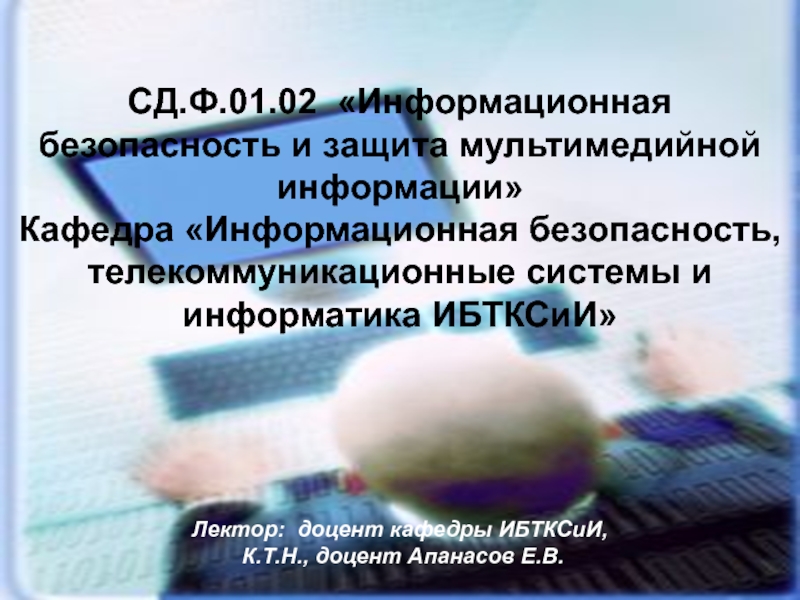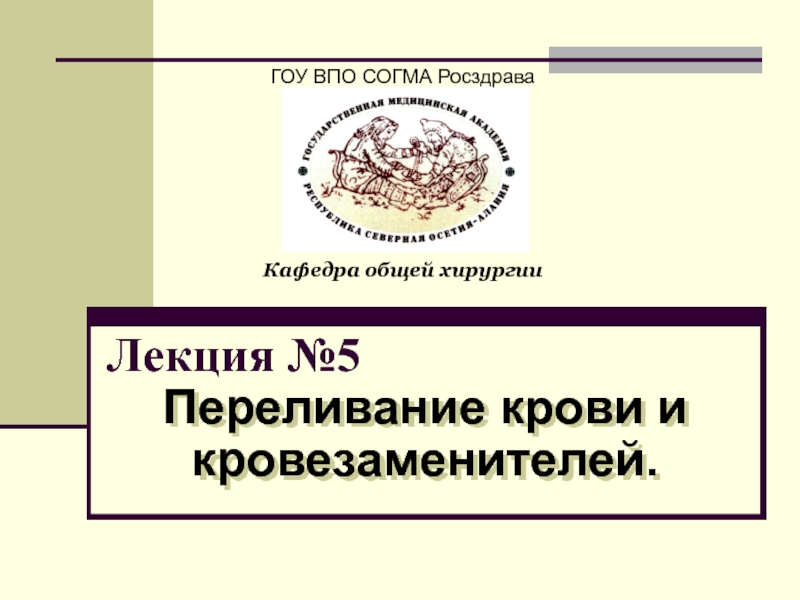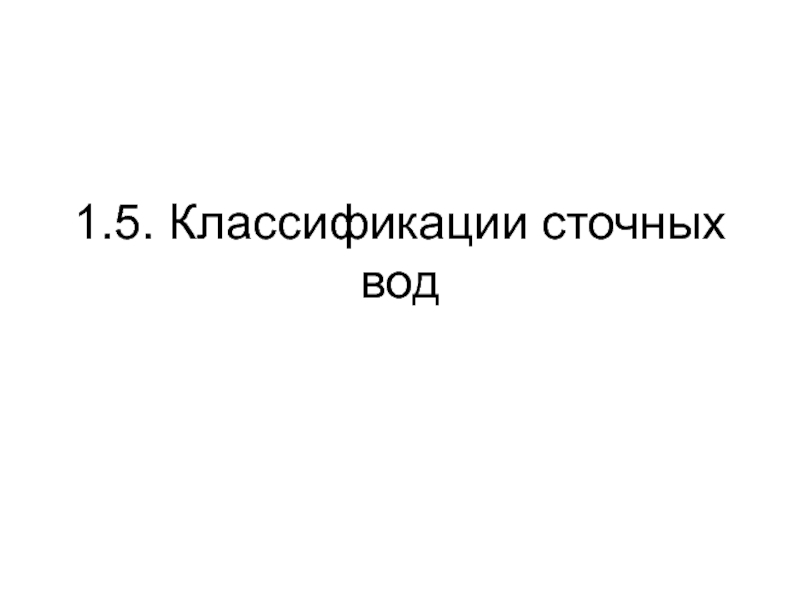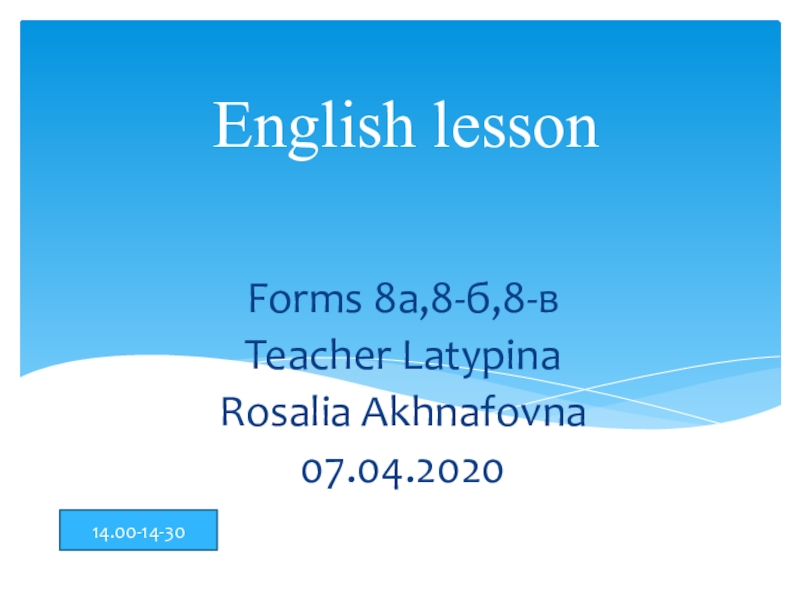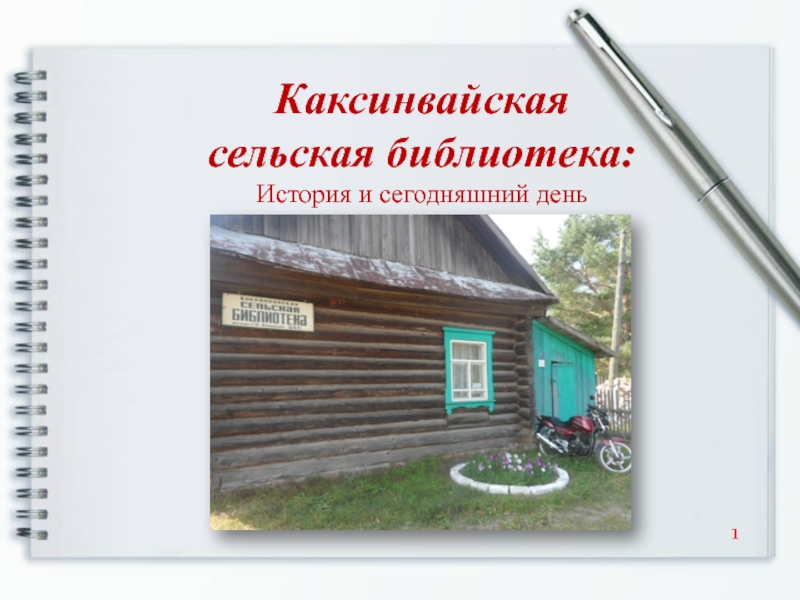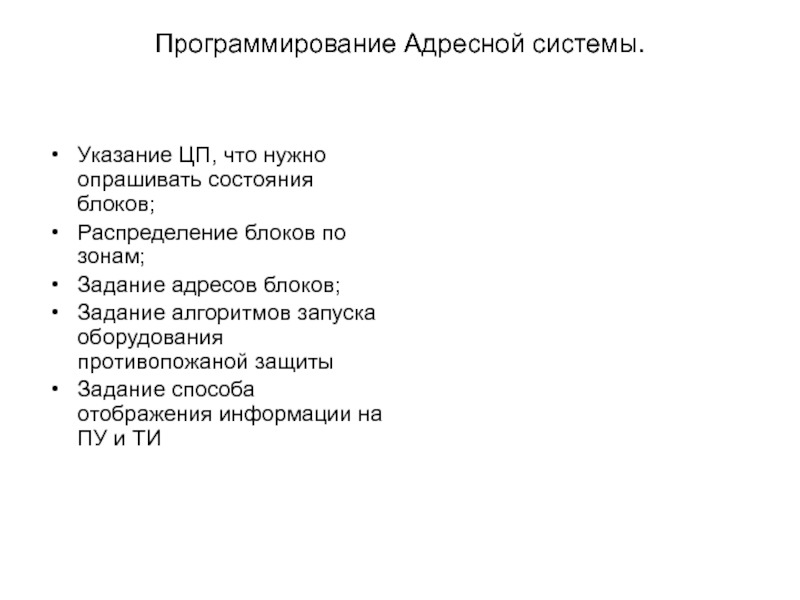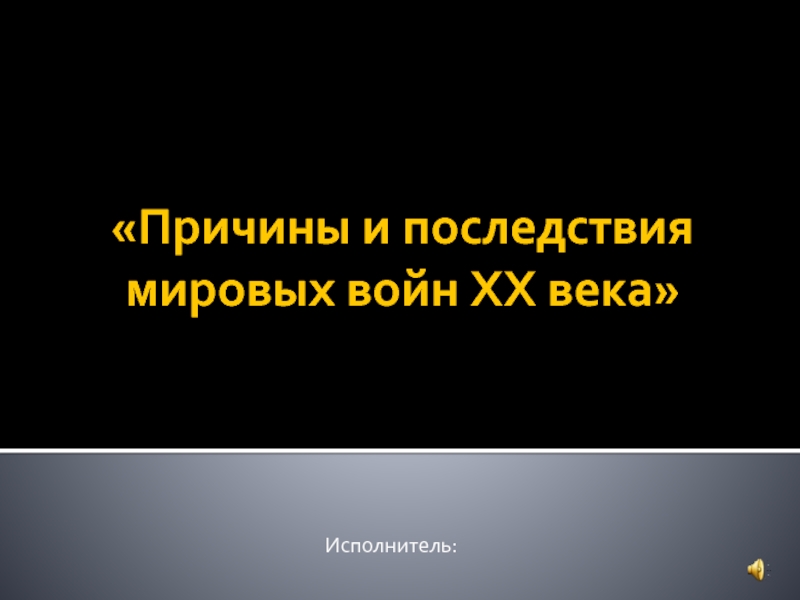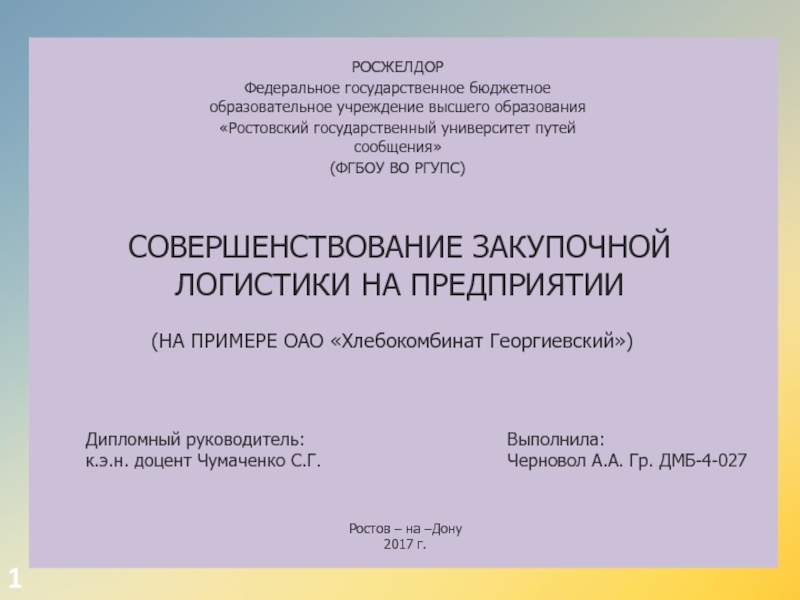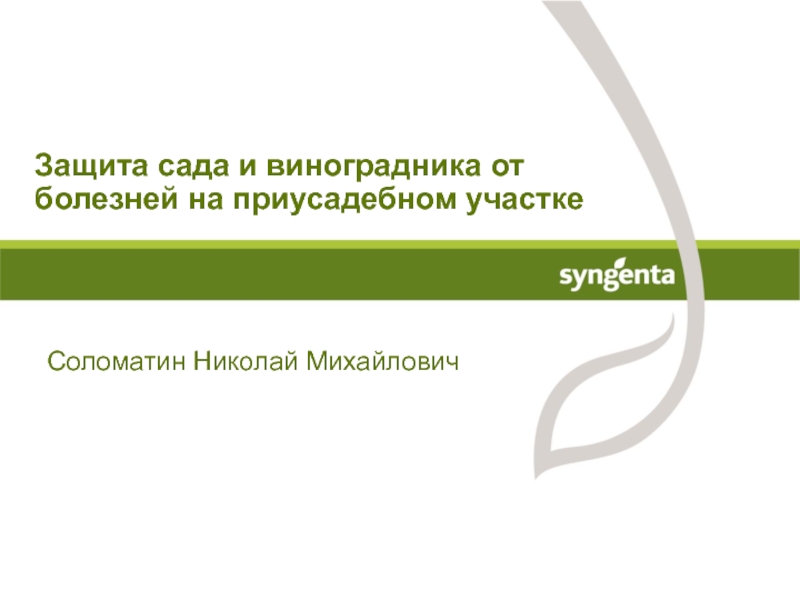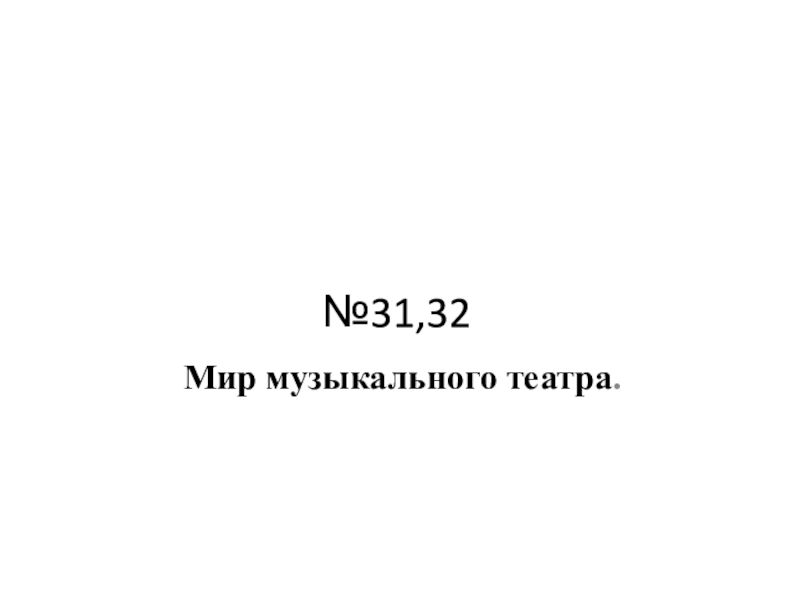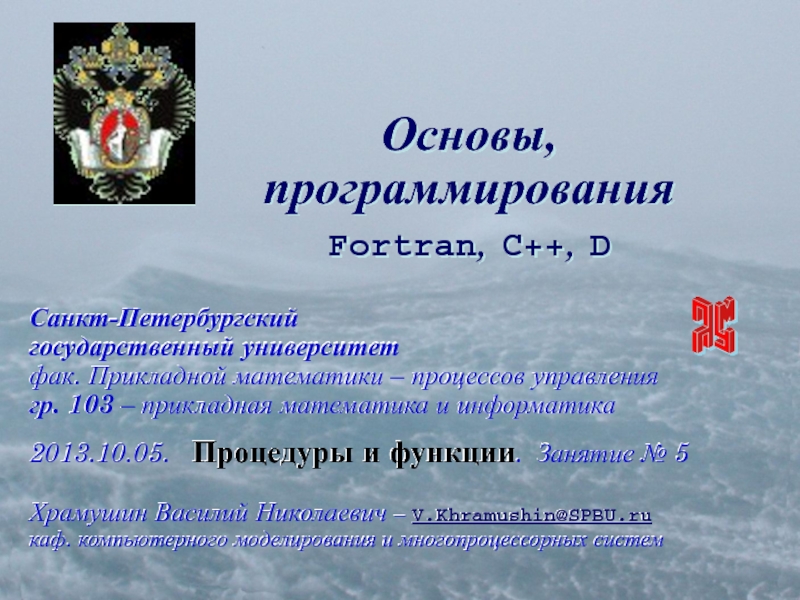Разделы презентаций
- Разное
- Английский язык
- Астрономия
- Алгебра
- Биология
- География
- Геометрия
- Детские презентации
- Информатика
- История
- Литература
- Математика
- Медицина
- Менеджмент
- Музыка
- МХК
- Немецкий язык
- ОБЖ
- Обществознание
- Окружающий мир
- Педагогика
- Русский язык
- Технология
- Физика
- Философия
- Химия
- Шаблоны, картинки для презентаций
- Экология
- Экономика
- Юриспруденция
Network Data Model
Содержание
- 1. Network Data Model
- 2. CONTENTSBrief historyNetwork data structureNetwork data structure operationsIntegrity constraintsAdvantages and drawbacks
- 3. Brief historyData Base Task Group (DBTG) CODASYL
- 4. Fields and record typesGraphic notation:TEACHER (Name, Post,
- 5. KeysTwo or more different records within a
- 6. Set type and instance (occurrence) Set type
- 7. Example of the set type and instanceDEPARTMENT
- 8. Multilevel HierarchyDEPARTMENT TEACHER
- 9. Representation of m:n relationshipsDEPARTMENT TEACHER
- 10. Schema and instance of m:n relationships
- 11. Cycles and loops PLANTCONTRACT
- 12. Possible categories of network schemas
- 13. Application and DBMSUser Work Area (UWA) contains:current state indicators,records,error status.
- 14. Network data model operationsData selection (Query Language
- 15. Data searching and selectionRecord location. A desired
- 16. Fine the record by DB-keyFIND [record-name] RECORD
- 17. Fine the record by field valuesIn order
- 18. Scanning a Set Occurrence The set occurrence
- 19. The next member record in the set
- 20. The prior member record in the set
- 21. The first and the last member record
- 22. Location of the owner record of the
- 23. ExampleX = ”T1”; FIND Teacher RECORD BY
- 24. Put a record occurrence into the databasecreate
- 25. Attaching record occurrence from DB to
- 26. Remove a record occurrence of a certain
- 27. Updating record occurrenceThe MODIFY command copies values
- 28. Deleting record occurrence from DBThe DELETE command
- 29. Advantages and drawbacksThe network data model basically
- 30. Скачать презентанцию
Слайды и текст этой презентации
Слайд 1Lecture 4. Network Data Model
National Aviation University
Computer Science Faculty
Department of
Software Engineering
Слайд 2CONTENTS
Brief history
Network data structure
Network data structure operations
Integrity constraints
Advantages and drawbacks
Слайд 3Brief history
Data Base Task Group (DBTG) CODASYL
DBTG reports in
1971 and 1978.
Network data model was proposed that supports
m:n relationshipsThe following DB languages was specified for the first time:
Schema DDL (conceptual level)
Subschema DDL (external level)
Stored Data Definition Language– SDDL (internal level)
DML
Implementation - Integrated Database Management System (IDMS) компании Cullinet Software, Inc.,
Слайд 4Fields and record types
Graphic notation:
TEACHER (Name, Post, Address)
Data field (item)
– elementary named data. Its instance (occurrence) is a data value.
Record type – is a uniquely named collection of field names:
TEACHER
Name
Post
Address
Record type instance – ordered collection of fields instances:
TEACHER
Johnson
professor
Kiev
Слайд 5Keys
Two or more different records within a network data base
may have duplicate values of all data items.
The Data Base
Key (DBK) is a unique internal identifier of any record. DBK is automatically assigned to any record when it is stored in DB and do not changed when a record is updated.CALC key is an internal identifier of any record, that assigned to a record on the base of values of a specified record fields.
Слайд 6Set type and instance (occurrence)
Set type is named two
level hierarchical relationship of the record types. With the help
of sets composition multilevel hierarchical and network structures may be constructed.Set owner. There is only one set owner record
Set members. There may be 0, 1 or more set member records.
Set instance (occurrence) consists of one instance of the owner record type and any number of instances of the member record types
Thus the set represent two level hierarchical one-to-many relationship.
Слайд 7Example of the set type and instance
DEPARTMENT
TEACHER
SUBJECT
logics
DBMS
С language
Peter
John
Ann
SE
Department Structure
Set owner
Set
members Set type Set instance
Set name
Слайд 8Multilevel Hierarchy
DEPARTMENT
TEACHER
SUBJECT
Department
Structure
BOOK
ARTICLE
Scientific Works
Owner
of the set «Department Structure»Members of the set «Department Structure»
Owner of the set «Scientific Works»
Members of the set «Scientific Works»
Слайд 9Representation of m:n relationships
DEPARTMENT
TEACHER
SUBJECT
Department Structure
BOOK
ARTICLE
Scientific
Works GROUP
LECTURE
Attend
Is taught at
Has
m:n
m:n
Слайд 10Schema and instance of m:n relationships
TEACHER
SUBJECT
LECTURE
Is_taught_at
Has
Teachers
Lectures
Subjects
SUBJECT
LECTUREIs_taught_at
Has
TEACHER
Слайд 13Application and DBMS
User Work Area (UWA) contains:
current state indicators,
records,
error status.
Слайд 14Network data model operations
Data selection (Query Language - QL):
FIND -
locates a described record occurrence
GET - reads a record occurrence
from the databaseData manipulation (Data Manipulation Language-DML):
STORE - puts a record occurrence into the database
INSERT - inserts member record into a set occurrence
REMOVE - removes member record from a set occurrence
DELETE - deletes current record from DB
MODIFY - updates current record
Слайд 15Data searching and selection
Record location. A desired record occurrence is
located. Located record occurrence becomes current. Current status indicator in
UWA points to a located record occurrenceThere is really set of FIND command that allow :
find the record by a key,
find any member record in a set occurrence,
scan a set occurrence for those member records having specified values in certain fields,
find an owner record of a given set occurrence.
FIND
Puts selected (current) record into UWA.
GET
Слайд 16Fine the record by DB-key
FIND [record-name] RECORD BY DATABASE KEY
[variable]
Syntax:
Example:
X=10;
FIND Faculty RECORD BY DATABASE KEY X;
If Error_Status=0
then GET Faculty; Else Print "Not Found !";
Слайд 17Fine the record by field values
In order to find a
record directly using known values of its fields, such fields
should be defined as so-called CALC-keys in the database schema.FIND [record-name] RECORD BY CALC-KEY
Syntax:
Example: Find lecture record with LID field value “L3”
(Field LID is defined as как CALC-field)
Lecture.LID = "L3";
FIND Lecture RECORD BY CALC-KEY;
Слайд 18Scanning a Set Occurrence
The set occurrence can be viewed
as a “ring” consisting of the owner record and all
of the member records. Member records are ordered within there owner record. SUBJECT
LECTURE
Is_taught_at
Has
TEACHER
Слайд 19The next member record in the set occurrence
FIND NEXT [record-name]
RECORD IN [set-name] SET
Syntax:
Example:
FIND NEXT Lecture RECORD IN Has SET;
Слайд 20The prior member record in the set occurrence
FIND PRIOR [record-name]
RECORD IN [set-name] SET
Syntax:
Пример:
FIND PRIOR Lecture RECORD IN Has SET;
Слайд 21The first and the last member record in the set
occurrence
FIND FIRST|LAST [record-name] RECORD IN [set-name] SET
Syntax:
Example:
FIND FIRST Lecture RECORD
IN Has SET;Current occurrence of the set “Has”
L1 - the first member record of
the set “Has”
Error_Status != 0 – the record
occurrence do not have
member records
L1 L2 L3 L4 L5
S1 S2 S3
T1 T2
Слайд 22Location of the owner record of the
current set occurence
FIND
OWNER OF [set-name] SET
Syntax:
Example:
FIND OWNER OF Has SET
Слайд 23Example
X = ”T1”;
FIND Teacher RECORD BY DATABASE KEY X;
FIND
LAST Lecture RECORD IN Has SET;
FIND OWNER OF Is_taught_at SET;
FIND
LAST Lecture RECORD IN Is_taught_at SET;FIND NEXT Lecture RECORD IN Has SET;
FIND OWNER OF Is_taught_at SET;
T1
L3
S2
L4
L5
S3
Слайд 24Put a record occurrence into the database
create a record occurrence
in UWA;
execute the command STORE.
STORE [record-name] RECORD
Syntax:
Example:
STORE Teacher RECORD
Stored record
automatically connected to the current set
occurrence.Слайд 25Attaching record occurrence from DB
to the set occurrence
Make required
set occurrence the current of set type
Make inserted record occurrence
the current oneExecute the command INSERT
INSERT [record-name] RECORD INTO [set-name] SET
Syntax:
Example:
X = 31; FIND Teacher RECORD BY DATABASE KEY x;
Y = 24; FIND Lecture RECORD BY DATABASE KEY y;
INSERT Lecture RECORD INTO Has SET;
Слайд 26Remove a record occurrence of a certain type from a
certain set occurrence
Make designated record be the current one
Execute the
command REMOVEREMOVE [record-name] RECORD FROM [set-name] SET
Syntax:
Example: Remove all lectures of the teacher with DBK 31.
x=31; FIND Teacher RECORD BY DATABASE KEY x;
Loop: FIND NEXT Lecture RECORD IN Has SET;
IF Error_Status=0 THEN
BEGIN; REMOVE Lecture RECORD FROM Teacher SET;
GO TO Loop;
END;
Слайд 27Updating record occurrence
The MODIFY command copies values from a record
in UWA into the current record occurrence of the DB.
Example: For teacher with DBK 31 change name to “Smith”.
x=31; FIND Teacher RECORD BY DATABASE KEY x;
GET Teacher RECORD;
Teacher.Name = ”Smith”;
MODIFY RECORD;
Слайд 28Deleting record occurrence from DB
The DELETE command removes from DB
the current
record occurrence
The set owner may be deleted
when this set do not
contains member recordsDELETE [record-name] RECORD
Syntax:
Example: Delete record with DBK 21.
x=21; FIND Lecture RECORD BY DATABASE KEY x;
DELETE Lecture RECORD;


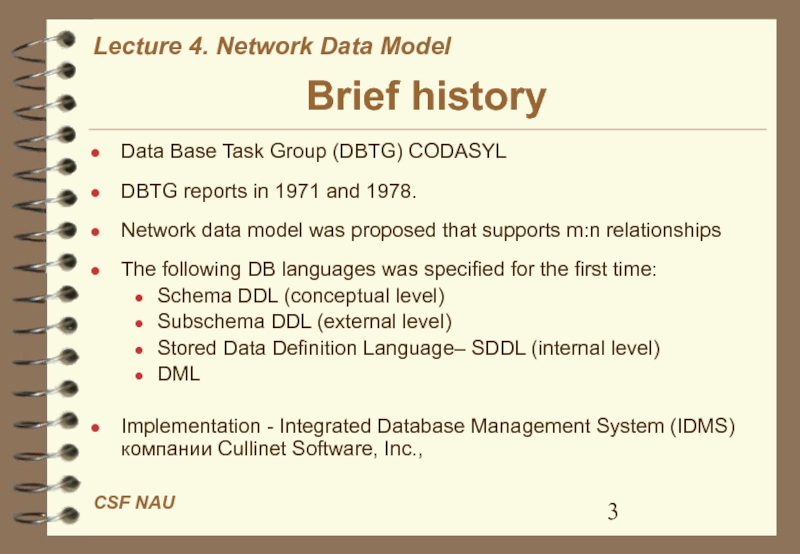
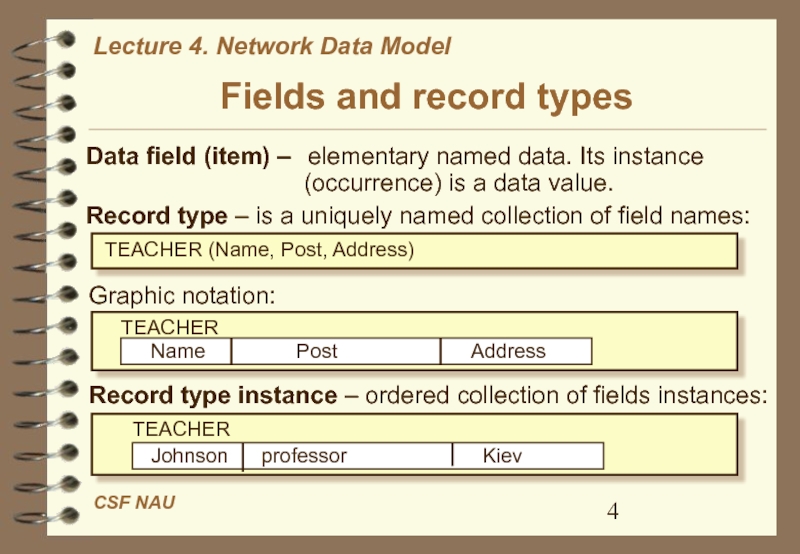
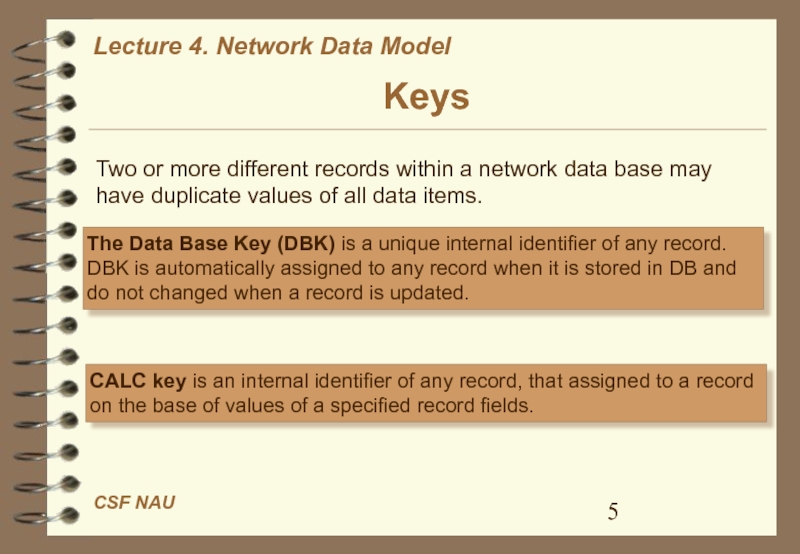
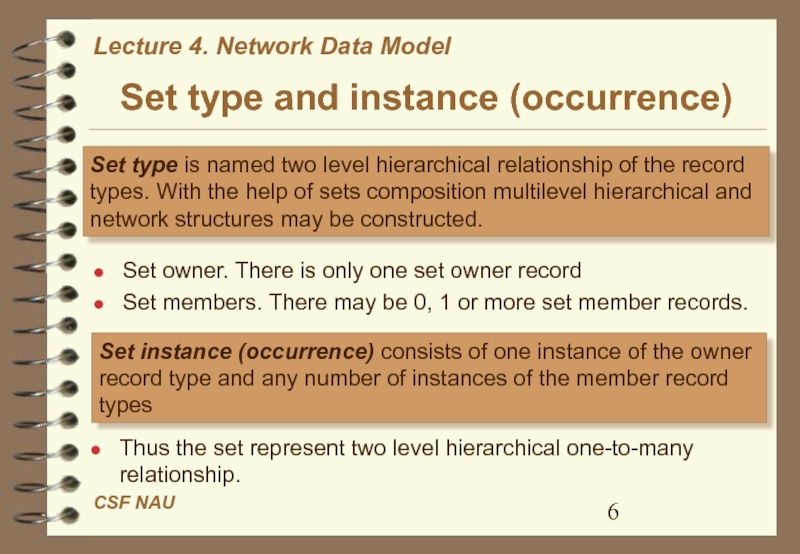
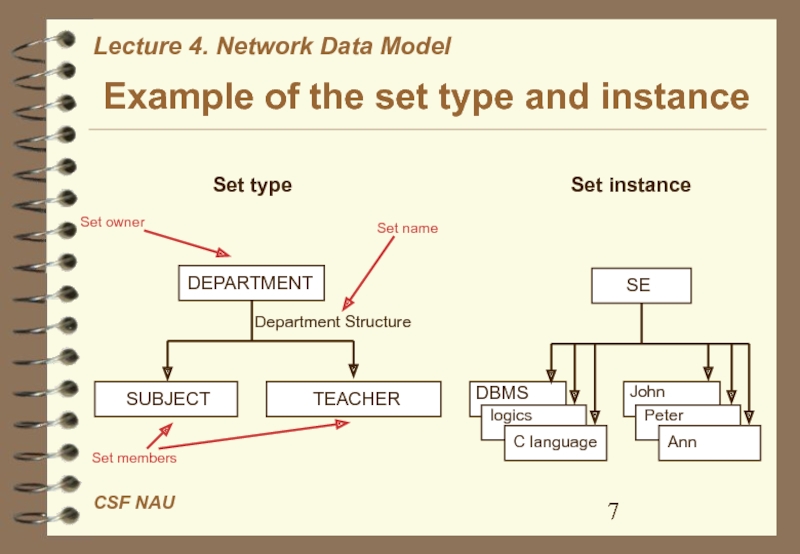
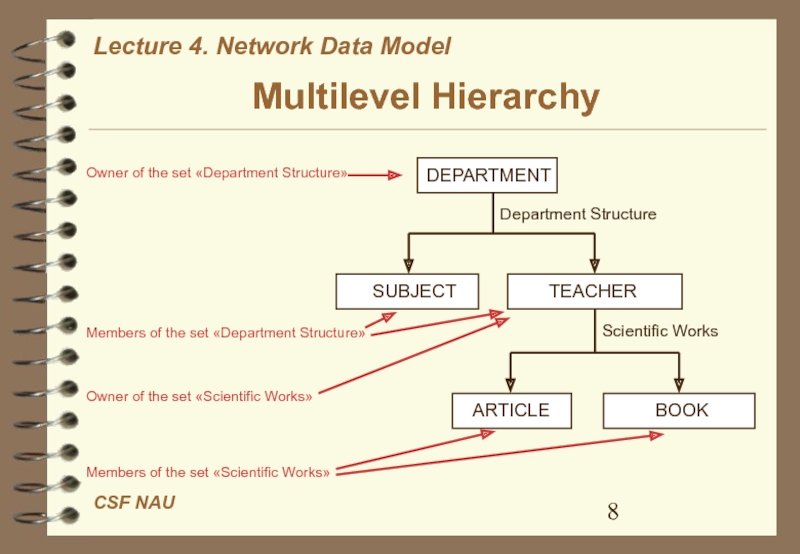
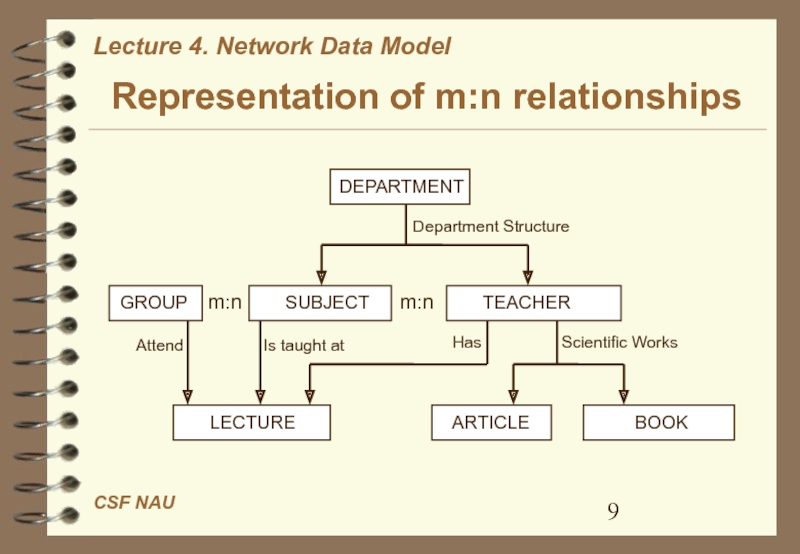
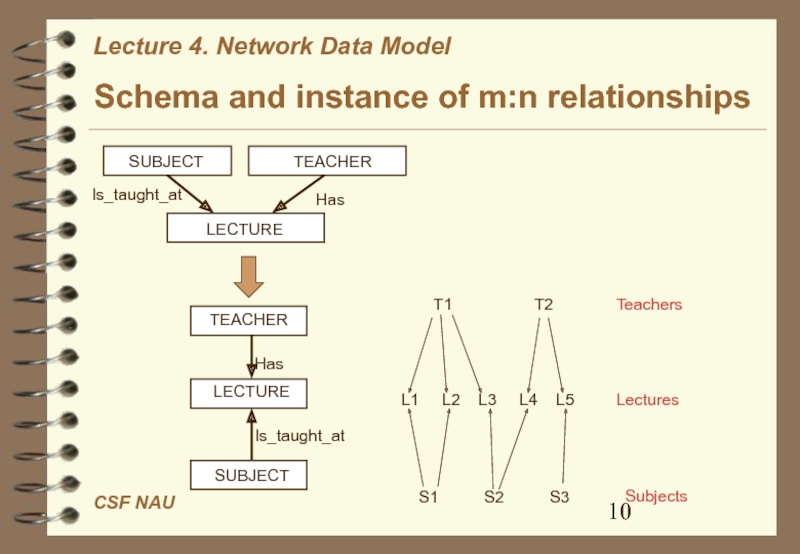
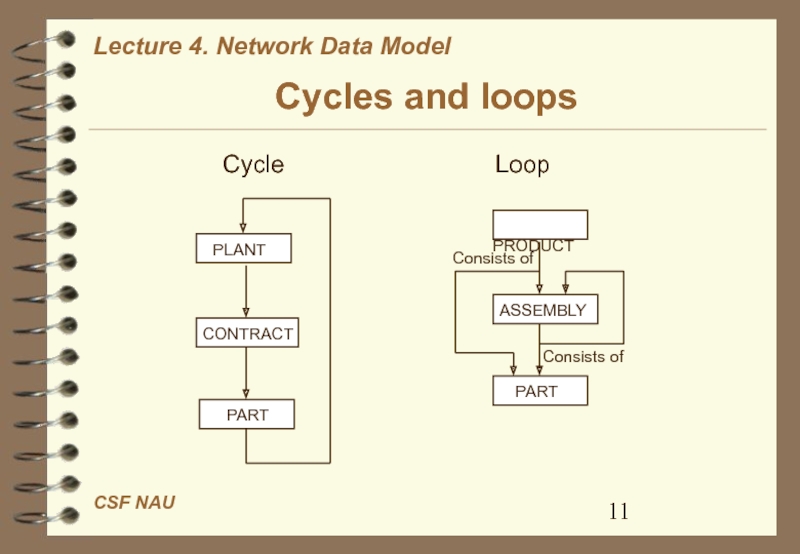
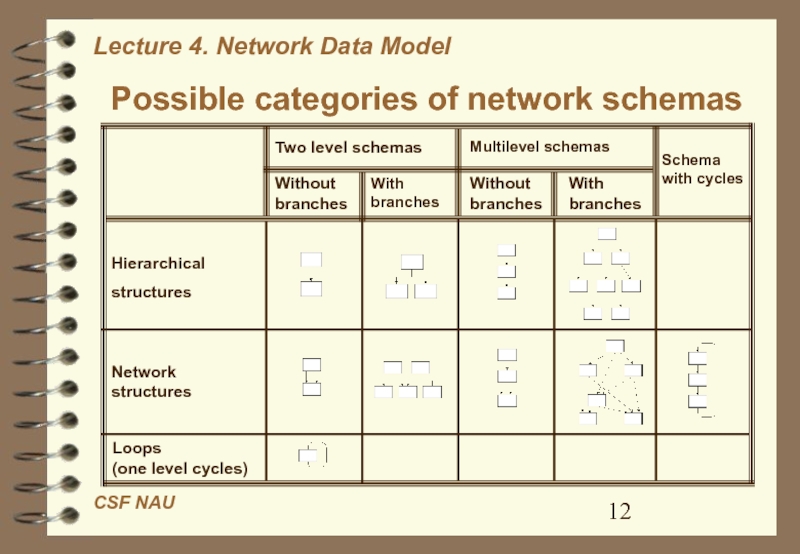
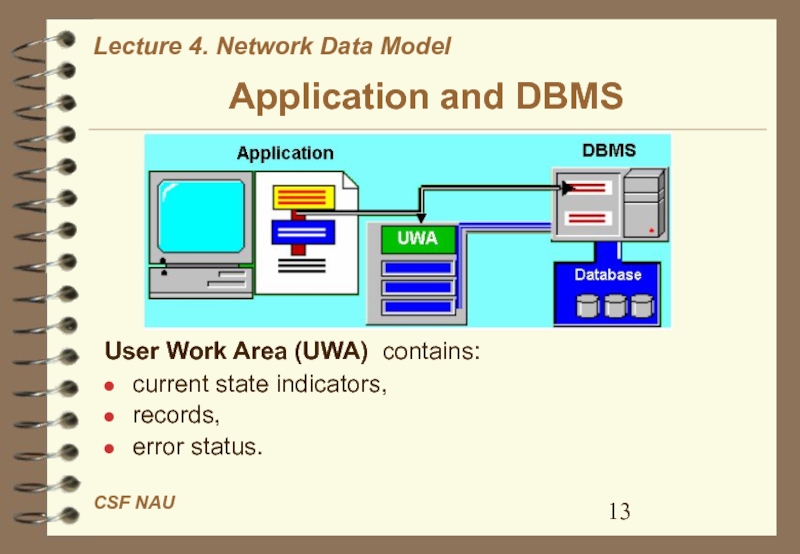

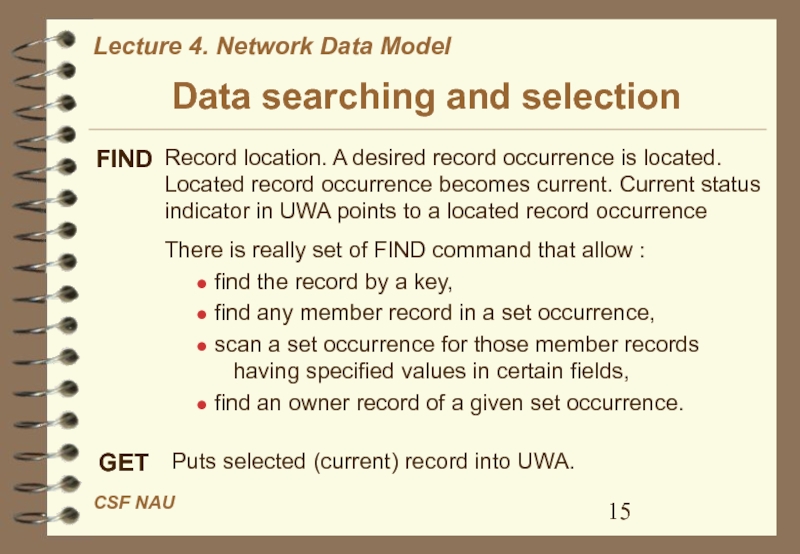
![Network Data Model Fine the record by DB-keyFIND [record-name] RECORD BY DATABASE KEY [variable]Syntax:Example:X=10; Fine the record by DB-keyFIND [record-name] RECORD BY DATABASE KEY [variable]Syntax:Example:X=10; FIND Faculty RECORD BY DATABASE KEY](/img/thumbs/8f6a8f29693fa65645e7df203e9726f9-800x.jpg)

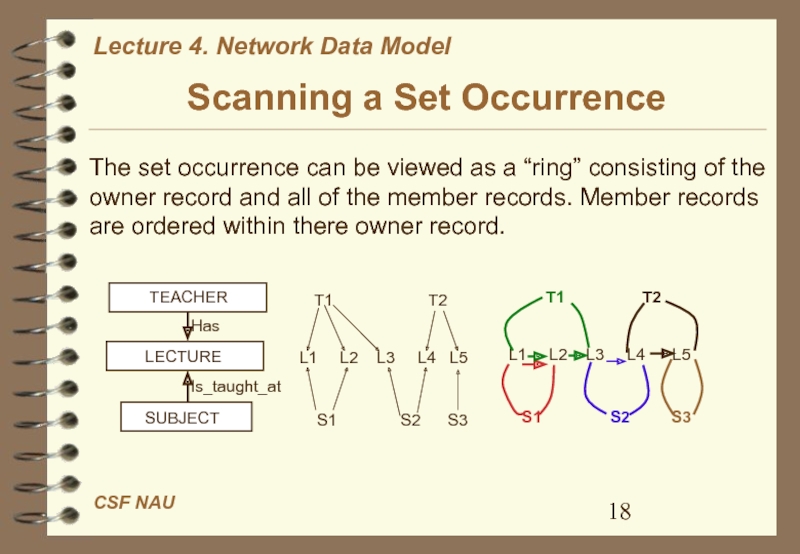
![Network Data Model The next member record in the set occurrenceFIND NEXT [record-name] RECORD The next member record in the set occurrenceFIND NEXT [record-name] RECORD IN [set-name] SETSyntax:Example:FIND NEXT Lecture RECORD](/img/thumbs/7b00d775dc98bc42b04f273cf6ed2fe7-800x.jpg)
![Network Data Model The prior member record in the set occurrenceFIND PRIOR [record-name] RECORD The prior member record in the set occurrenceFIND PRIOR [record-name] RECORD IN [set-name] SETSyntax:Пример:FIND PRIOR Lecture RECORD](/img/thumbs/e4732e9e8d85ed1cd08e648cc5c8e626-800x.jpg)
![Network Data Model The first and the last member record in the set occurrenceFIND The first and the last member record in the set occurrenceFIND FIRST|LAST [record-name] RECORD IN [set-name]](/img/thumbs/ffff76374a8b4ebe1255262dca39489d-800x.jpg)
![Network Data Model Location of the owner record of the current set occurenceFIND OWNER Location of the owner record of the current set occurenceFIND OWNER OF [set-name] SETSyntax:Example:FIND OWNER OF](/img/thumbs/b1df4da08b360461eb3f2acb597d3fe8-800x.jpg)
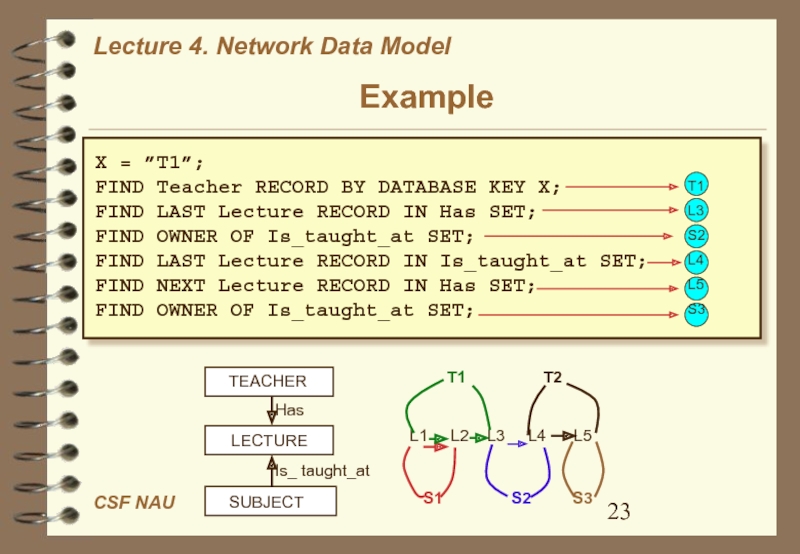
![Network Data Model Put a record occurrence into the databasecreate a record occurrence in Put a record occurrence into the databasecreate a record occurrence in UWA;execute the command STORE.STORE [record-name] RECORDSyntax:Example:STORE](/img/thumbs/5df46bc27226bbd9b316b1e63ae6e45c-800x.jpg)
